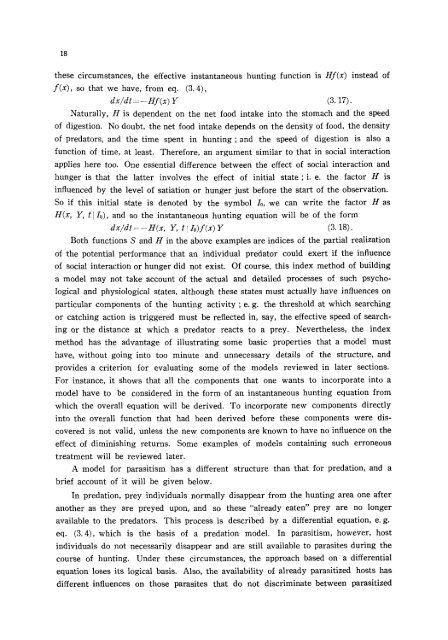A comparative study of models for predation and parasitism
A comparative study of models for predation and parasitism
A comparative study of models for predation and parasitism
You also want an ePaper? Increase the reach of your titles
YUMPU automatically turns print PDFs into web optimized ePapers that Google loves.
18<br />
these circumstances, the effective instantaneous hunting function is Hf(x) instead <strong>of</strong><br />
f(x), so that we have, from eq. (3.4),<br />
dx/dt =--Hf(x) Y (3.17).<br />
Naturally, H is dependent on the net food intake into the stomach <strong>and</strong> the speed<br />
<strong>of</strong> digestion. No doubt, the net food intake depends on the density <strong>of</strong> food, the density<br />
<strong>of</strong> predators, <strong>and</strong> the time spent in hunting; 3nd the speed <strong>of</strong> digestion is also a<br />
function <strong>of</strong> time, at least. There<strong>for</strong>e, an argument similar to that in social interaction<br />
applies here too. One essential difference between the effect <strong>of</strong> social interaction <strong>and</strong><br />
hunger is that the latter involves the effect <strong>of</strong> initial state ; i. e. the factor H is<br />
influenced by the level <strong>of</strong> satiation or hunger just be<strong>for</strong>e the start <strong>of</strong> the observation.<br />
So if this initial state is denoted by the symbol I0, we can write the factor H as<br />
H(x, Y, t]I0), <strong>and</strong> so the instantaneous hunting equation will be <strong>of</strong> the <strong>for</strong>m<br />
dx/dt=-H(x, Y, t! Io)f(x) Y (3.18).<br />
Both functions S <strong>and</strong> H in the above examples are indices <strong>of</strong> the partial realization<br />
<strong>of</strong> the potential per<strong>for</strong>mance that an individual predator could exert if the influence<br />
<strong>of</strong> social interaction or hunger did not exist. Of course, this index method <strong>of</strong> building<br />
a model may not toke account <strong>of</strong> the actual <strong>and</strong> detailed processes <strong>of</strong> such psycho-<br />
logical <strong>and</strong> physiological states, although these states must actually have influences on<br />
particular components <strong>of</strong> the hunting activity ; e.g. the threshold at which searching<br />
or catching action is triggered must be reflected in, say, the effective speed <strong>of</strong> search-<br />
ing or the distance at which a predator reacts to a prey. Nevertheless, the index<br />
method has the advantage <strong>of</strong> illustrating some basic properties that a model must<br />
have, without going into too minute <strong>and</strong> unnecessary details <strong>of</strong> the structure, <strong>and</strong><br />
provides a criterion <strong>for</strong> evaluating some <strong>of</strong> the <strong>models</strong> reviewed in later sections.<br />
For instance, it shows that all the components that one wants to incorporate into a<br />
model have to be considered in the <strong>for</strong>m <strong>of</strong> an instantaneous hunting equation from<br />
which the overall equation will be derived. To incorporate new components directly<br />
into the overall function that had been derived be<strong>for</strong>e these components were dis-<br />
covered is not valid, unless the new components are known to have no influence on the<br />
effect <strong>of</strong> diminishing returns.<br />
treatment will be reviewed later.<br />
Some examples <strong>of</strong> <strong>models</strong> containing such erroneous<br />
A model <strong>for</strong> <strong>parasitism</strong> has a different structure than that <strong>for</strong> <strong>predation</strong>, <strong>and</strong> a<br />
brief account <strong>of</strong> it will be given below.<br />
In <strong>predation</strong>, prey individuals normally disappear from the hunting area one after<br />
another as they ~re preyed upon, <strong>and</strong> so these "already eaten" prey are no longer<br />
available to the predators. This process is described by a differential equation, e.g.<br />
eq. (3. 4), which is the basis <strong>of</strong> a <strong>predation</strong> model. In <strong>parasitism</strong>, however, host<br />
individuals do not necessarily disappear <strong>and</strong> are still available to parasites during the<br />
course <strong>of</strong> hunting. Under these circumstances, the approach based on a differential<br />
equation loses its logical basis. Also, the availability <strong>of</strong> already parasitized hosts has<br />
different influences on those parasites that do not discriminate between parasitized















